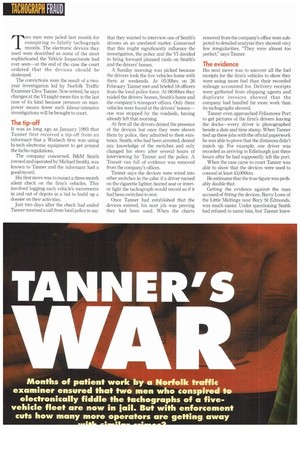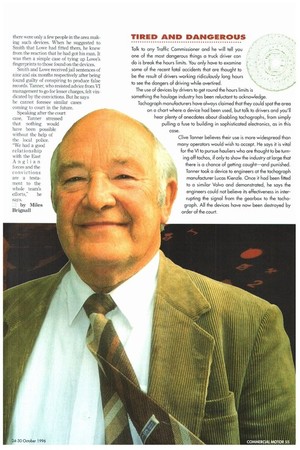T wo men were jailed last month for conspiring to falsify
Page 56

Page 57

If you've noticed an error in this article please click here to report it so we can fix it.
tachograph records. The electronic devices they used were described as some of the most sophisticated the Vehicle Inspectorate had ever seen—at the end of the case the court ordered that the devices should be destroyed.
The convictions were the result of a twoyear investigation led by Norfolk Traffic Examiner Clive Tanner. Now retired, he says changes at the VI might mean this is the last case of its kind because pressure on manpower means fewer such labour-intensive investigations will be brought to court.
It was as long ago as January 1993 that Tanner first received a tip-off from an informant that a Wisbech firm was using hi-tech electronic equipment to get around the tacho regulations.
The company concerned, B&M Smith (owned and operated by Michael Smith), was known to Tanner and the informant had a good record.
His first move was to mount a three-month silent check on the firm's vehicles. This involved logging each vehicle's movements in and out of depots in a bid to build up a dossier on their activities.
Just two days after the check had ended Tanner received a call from local police to say that they wanted to interview one of Smith's drivers on an unrelated matter. Concerned that this might significantly influence the investigation, the police and the VI decided to bring forward planned raids on Smith's and the drivers' homes.
A Sunday morning was picked because the drivers took the five vehicles home with them at weekends. At 05:30hrs on 26 February Tanner met and briefed 18 officers from the local police force. At 08:00hrs they raided the drivers' homes, Smith's home and the company's transport offices. Only three vehicles were found at the drivers' homes— one was stopped by the roadside, having already left that morning.
At first all the drivers denied the presence of the devices but once they were shown them by police, they admitted to their existence. Smith, who had been arrested, denied any knowledge of the switches and only changed his story after several hours of interviewing by Tanner and the police. A Transit van full of evidence was removed from the company's offices.
Tanner says the devices were wired into other switches in the cabs: if a driver turned on the cigarette lighter, heated seat or interior light the tachograph would record as if it had been switched to rest.
Once Tanner had established that the devices existed, his next job was proving they had been used. When the charts removed from the company's office were subjected to detailed analysis they showed very few irregularities. "They were almost too perfect," says Tanner.
His next move was to uncover all the fuel receipts for the firm's vehicles to show they were using more fuel than their recorded mileage accounted for. Delivery receipts were gathered from shipping agents and duplicate invoices showed that the company had handled far more work than its tachographs showed.
Tanner even approached Felixstowe Port to get pictures of the firm's drivers leaving the docks—every driver is photographed beside a date and time stamp. When Tanner tied up these jobs with the official paperwork he was able to prove that the distances didn't match up. For example, one driver was recorded as arriving in Edinburgh just three hours after he had supposedly left the port.
When the case came to court Tanner was able to show that the devices were used to conceal at least 43,000km.
He estimates that the true figure was probably double that.
Getting the evidence against the man accused of fitting the devices, Barry Lowe of the Little Makings near Bury St Edmonds, was much easier. Under questioning Smith had refused to name him, but Tanner knew there were only a few people in the area making such devices. When he suggested to Smith that Lowe had fitted them, he knew from the reaction that he had got his man. It was then a simple case of tying up Lowe's fingerprints to those found on the devices.
Smith and Lowe received jail sentences of nine and six months respectively after being found guilty of conspiring to produce false records. Tanner, who resisted advice from VI management to go for lesser charges, felt vindicated by the convictions. But he says he cannot foresee similar cases coming to court in the future.
Speaking after the court case, Tanner stressed that nothing would have been possible without the help of the local police. "We had a good relationship with the East Anglian forces and the convictions are a testament to the whole team's efforts," he says.
—1 by Miles Brignall




















































































































